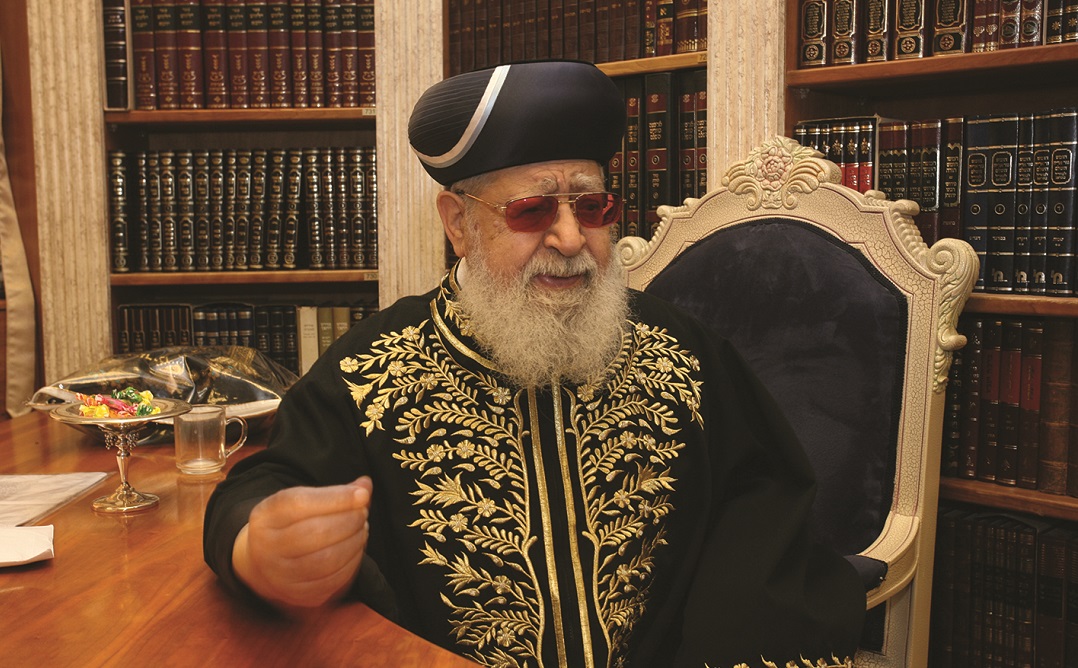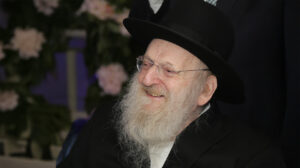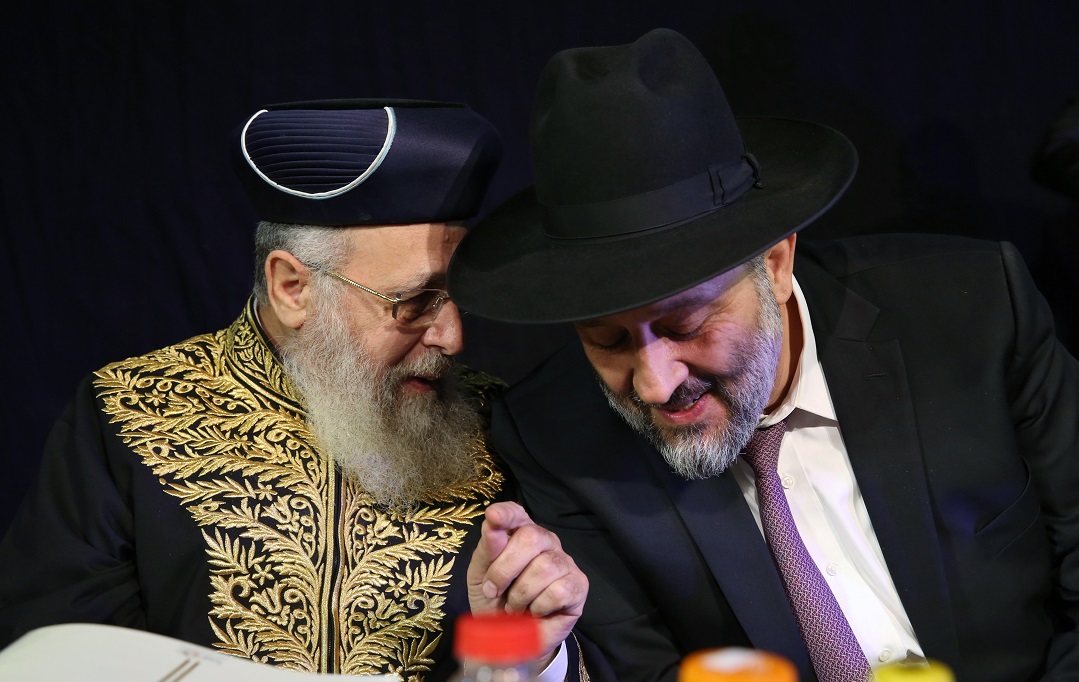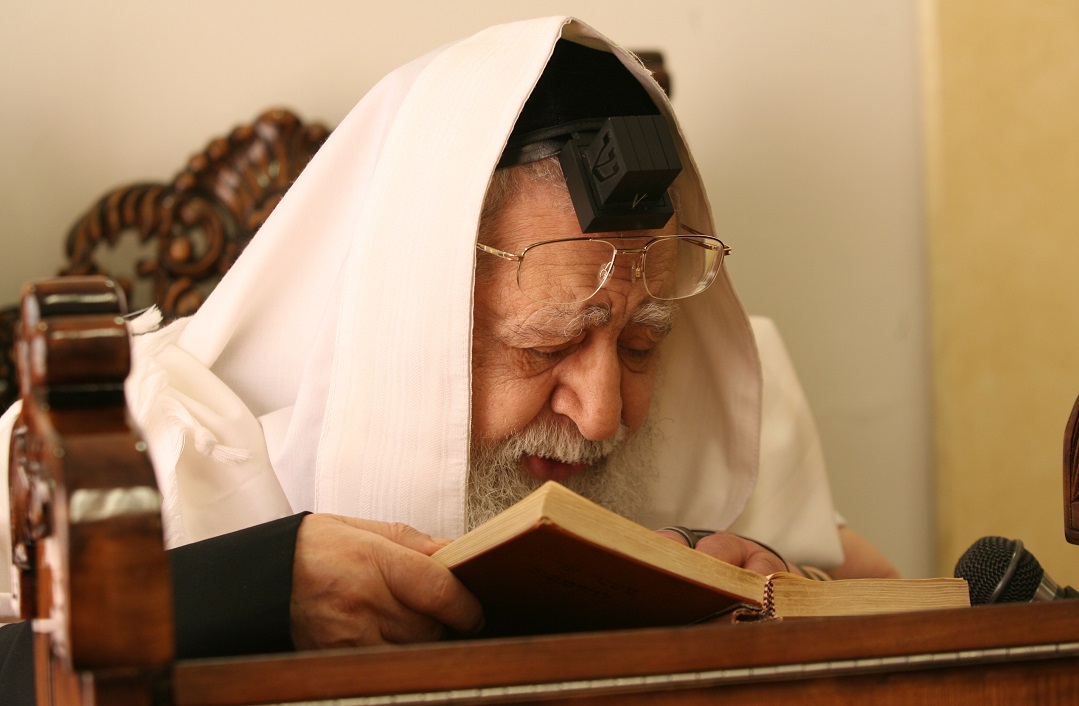A Crown Restored

For Rav Ovadiah Yosef, Torah was a single consuming passion, dearer to him than his daily bread. Yet even as he rose to prominence as one of the generation’s premier gedolim and halachic arbiters, Rav Ovadiah achieved another mission. It was his calling to restore the glory of his ancestors’ tradition to its rightful place in every sphere — on the halachic bookshelf, in the rulings of the chief rabbinate, at the voting booth, and inside the Knesset, and even within the children’s classrooms. An unlikely yet brilliant architect, he steadily charted change in social, political, and cultural spheres.
Still, no matter what concerns filled his daily schedule, he started and ended every day in the same legendary library, immersed in the same beloved sefarim. As he succeeded in restoring the crown to the rich Sephardic heritage, he unwittingly gained a crown of his own — the respect and reverence of an entire generation.

O
ver the last few weeks all eyes were focused on the eighth floor of Hadassah Medical Center by a nation steeped in beseeching supplication, but the request for life was not granted. On Monday, 3 Marcheshvan at 1:30, Hashem took back the holy soul He deposited with a righteous couple in an Iraqi village 93 years ago.
The monthlong hospital vigil over Rav Ovadiah Yosef ztz”l mirrored a similar crisis exactly seven years ago. But as children, grandchildren, disciples, and adherents stormed the Heavens with their prayers these last weeks, they hoped against hope: would Hashem grant another reprieve?
In 2006, too, the prognosis was bleak. Maran HaGaon HaRav Ovadiah was in grave danger. His heart condition had worsened, complicated by other ailments, and the medical team decided to operate. Attached to numerous machines and tubes, Rav Ovadiah lay pale and weak, his breathing labored, his blood pressure yo-yoing dangerously; he could barely hold up his head. But his pocket-sized Gemara never left his bedside, remaining open until the moment the anesthesia was administered.
Awakening after the operation, Rav Ovadiah didn’t ask about his condition or the operation’s success. He asked only for water for netilas yadayim and immediately resumed learning from where he’d left off.
To check if his father was as alert as he seemed, one son asked him the source of a certain quote.
“In the Chida’s sefer, Tov Ayin,” Rav Ovadiah murmured weakly.
“When did Abba last see this quote?” the son persisted.
“Sixty-three years ago,” Rav Ovadiah whispered.
His son tried to continue the conversation. “Abba, maybe you remember what you ate for lunch today?”
Rav Ovadiah shook his head. “I don’t remember.”
Surrounding his bed, his relatives breathed a sigh of relief. “That’s Abba. He remembers what he learned 63 years ago, but not what he ate today. He must be out of danger.”
Sunrise from the East In a humble house on the banks of the Tigris River in Baghdad’s Jewish quarter, Chacham Yaakov Ovadiah, scholar and paytan, had just named his firstborn son — born on 12 Tishrei 1920 — for the two great lights of Iraqi Jewry, Rav Ovadiah (Abdullah) Somech and his disciple, Rav Yosef Chaim, the Ben Ish Chai. In 1924, when Ovadiah Yosef Ovadiah (his name was shortened later on) was four years old, the family immigrated to Eretz Yisrael, settling in Jerusalem’s Beis Yisrael neighborhood.
At age six, little Ovadiah began to learn Gemara and enrolled in Talmud Torah Bnei Tzion founded by Rabbi Moshe Porush. At 12, the child illui was enrolled in Yeshivat Porat Yosef — then located in the Old City — where he became a chavrusa of Rosh Yeshivah Rav Ezra Attiyah.
In those dangerous days, Porat Yosef locked its doors from early evening, so that boys living outside the Old City would not travel home after dark. And so young Ovadiah would walk with his close friend, Ben Zion Abba Shaul (later to become a famous Sephardic gadol in his own right), to Chevron Yeshivah, in the Geula neighborhood. They measured the distance by Gemara pages: “Yeshivat Chevron is five daf away from Porat Yosef.” There they would continue their learning until early morning.
One day, during the hunger years of the late 1930s, Ovadiah’s place in Porat Yosef was empty. Rav Attiyah inquired after him, and was shocked to learn that Chacham Yaakov had put his son to work in his grocery store. Concern for the boy’s future led Rav Ezra to the small store, and there sat Ovadiah, his Gemara open on the dusty counter.
Chacham Yaakov explained to his distinguished visitor that he had no choice; the needs of his growing family required him to seek other sources of livelihood and he required his son to mind the store while he worked elsewhere.
Rav Ezra lifted the hem of his rabbinic robe and walked behind the long counter. “I will be clerk from now on. Ovadiah belongs in yeshivah.”
Chacham Yaakov kissed the Rosh Yeshivah’s hand, begging forgiveness, and together, rebbi and talmid returned to Porat Yosef.
Ovadiah continued his steady climb toward greatness. In time, Rav Avraham Fattal, a leading Syrian mekubal and chavrusa of Rav Shalom Sharabi, approached Rav Ezra Attiyah, asking him to recommend an outstanding young man for his daughter, Margalit. Rav Fattal didn’t conceal the facts from his daughter: “We’re talking about the illui of the yeshivah. But you should know that the boy is a pauper, from an impoverished family.” Undeterred, the girl who had shouldered the burden of an entire household ever since her own mother died took upon herself the yoke of Torah, despite the poverty it entailed.
On Erev Pesach 1944, the young couple was wed. Those times were fraught with danger, war, and hunger; the wedding guests, including Jerusalem’s most esteemed rabbanim, were served candies and a glass of wine.
The couple rented a tiny room in the Beis Yisrael neighborhood, where the entire building shared the outdoor facilities. They had nothing, not even cutlery or dishes.
During the hunger and privation of the war years in the late 1940s, Rav Ovadiah was forced to accept a position as av beis din of Cairo. But Egypt was a spiritual desert at the time — there were no Torah scholars there and there was no communication with Palestine, so the young rav was forced to render halachic decisions on his own, without the benefit of discussion with colleagues. That experience, he would later acknowledge, developed his confidence to rule decisively.
Bread and Salt
The family returned to a Jerusalem stricken by the ravages of war. Rav Ovadiah may have been the pride of Porat Yosef, but when he visited the yeshivah after his stint in Cairo, he was refused acceptance to the kollel. “We have no more money, nothing, and besides, you’re too old for us,” said the director.
Rav Tzvi Pesach Frank, rav of Yerushalayim, presided over a kollel called Medrash Bnei Tzion. He invited Rav Ovadiah to join a chaburah that boasted such scholars as Rav Shlomo Zalman Auerbach and Rav Yisrael Yaakov Fisher. Rav Ovadiah was the first, and lone, Sephardic member in that elite group.
Rav Ovadiah, whose ability to quote an entire library of sources was legendary, would always object to those who claimed his advantage was that he was gifted with an excellent memory. “Do you know how many times I reviewed this masechta? Every halachah? Every dvar Torah? It’s not just memory!” he once told Mishpacha’s Yossi Elituv.
Rav Ovadiah was accruing riches in Torah, but the family — as per Chazal’s dictum — was literally living on bread and water.
“We grew up in dire poverty,” his son Rav Yitzchak Yosef, today Israel’s Sephardic chief rabbi, told Mishpacha in an interview several years ago. “We couldn’t wait for Shabbat. We knew that at least at the seudah, we’d get a quarter cup of beer. We owned only a few pieces of clothing, which were shared among the children.”
When the Yosefs were blessed with 11 children, they finally moved to their own four-room apartment at 8 Elkanah Street. It was considered a palace, even though the children slept on folding beds, the furniture was ancient, and the refrigerator was an old icebox.
Rav David Yosef shared his memories of one momentous occasion. “When I was five, Abba came home beaming. He had saved up and managed to buy a fridge and washing machine. We children were overjoyed. As the fridge was placed in the kitchen, we sang and danced.”
Any outsider would have described the Yosef family’s years on Rechov Elkanah as a terribly destitute period. But Rav David has sweet memories of those years in the Tel Arza neighborhood. “It might have been the most peaceful time in Abba’s life, before he became chief rabbi,” he reflects. “Abba sat on the beit din with a very close-knit group of friends — Rav Elyashiv, Rav Eliezer Goldschmidt, and Rav Betzalel Zolty [later to become the chief rabbi of Yerushalayim], and they were constantly conferring with each other. Often, I would come home at night to see these great geonim huddled around the table, discussing whatever issue they were facing in beit din.
“We lived on the first floor of the building, and Rav Ben Zion Abba Shaul lived on the second. Abba and Rav Ben Zion were childhood friends from Porat Yosef, and they would frequently speak in learning. Many years later, when I was rav of Har Nof, there was a complex sh’eilah involving an apartment situated on top of a shul, and someone quoted a psak from Rav Ben Zion. So I went to discuss it with him personally, and he told me that the case in question was no problem. ‘But I faced a real problem,’ he told me, ‘back when we lived in that building in Tel Arza. Your father sat and learned just underneath our apartment, creating a beit medrash in his living room.’”
On leil Shabbos, Rav Ovadiah found it impossible to sleep due to the heightened kedushah of the day, and he would learn until Shacharis.
“He would start off with all of us boys surrounding him, and one by one, we would all drop off and he would remain alone, engrossed in the sugya,” Rav David remembers.
But the constant exertion, lack of sleep, and poor nutrition over the years took its toll on Rav Ovadia’s health, eventually affecting his eyesight to the extent that doctors feared he might lose his sight entirely. On hearing this, Rav Ovadiah wasted no time and traveled immediately to Tzfas. There, at the gravesite of Rav Yosef Karo, he shed torrents of tears, begging, “I abided by the Beit Yosef’s rulings, always fighting that halachah should be practiced according to your decisions!” Gradually, his vision improved, and he returned to his regular study schedule. His dark glasses were the sole reminder of that precarious time.
As a teenager, Rav David Yosef learned how to type, and as such, he became indispensable to his father. “He would write teshuvot by hand and give them to me to type up for his sefarim. When I was 17, I gave a shiur in Katamon each evening. But I was so valuable to him that he would sometimes tell me to keep on typing and that he would deliver the shiur in my stead. The shiur was always well-attended, because the participants knew that at least twice a week, they would merit hearing shiur from Abba, not me.”
Restoring the Crown
The young gaon and dayan was appointed to the Petach Tikvah beis din in 1956, and eventually as a member of the prestigious beis din of the Jerusalem rabbinate, where he sat alongside Rav Yosef Shalom Elyashiv. In 1968, he was elected chief rabbi of Tel Aviv–Yaffo.
Back in the 1950s, his sefarim and written teshuvos took the Torah world by storm. His first sefer, Chazon Ovadiah, was hailed as a groundbreaking work, as were the first two volumes of his major work, Yabia Omer. His breadth of knowledge was astounding, not just in the traditional Sephardic poskim but across the board; he was as familiar with the writings of Transylvanian rabbanim as with the geonim of Poland.
He opened Ohr HaTorah, a yeshivah that aimed to raise the level of Torah learning among Sephardim. It was the first of many institutions he established for the purpose.
The name of Chacham Ovadiah spread, and he was elected to the position of Rishon L’Tzion, Sephardic chief rabbi of Israel, in 1973. In the decades since, he established — along with his children — numerous yeshivos and kollelim, and he set policy for Sephardic bnei Torah everywhere, becoming the leading halachic arbiter for the entire Sephardic world. He made it his life’s mission to defend and uphold the halachic rulings of Maran, the Beit Yosef.
An oft-repeated slogan of his were the words of Chazal, “L’hachazir atarah l’yoshnah” — to restore the crown to its rightful place. Halachically, he used the term to refer to primacy of the Beit Yosef’s rulings in Sephardic life.
But it wasn’t at all about him, about his sefarim or even about the Beit Yosef. He had an overarching grand vision of restoring Sephardic Torah, heritage and pride to its former glory.
And so, with the backing of Rav Elazar Menachem Shach, Rav Ovadiah was instrumental in founding the Shas political party to represent the interests of Sephardic bnei Torah and to serve as a bridge between the Torah world and the greater Sephardic community in Israel. With their wide-ranging support, Shas — and Rav Ovadiah himself — became a major player on the Israeli political scene.
It’s All About Torah
Rav Ovadiah might have been considered one of the main movers and shakers of Israel’s political community in his later years, but it was Torah, and his precious sefarim, that were his lifeline, his very oxygen. During his tenure as chief rabbi, he once climbed a ladder to reach a sefer on a high shelf. While still standing on the top rung, he began studying the sefer and was soon lost in its pages. After two hours, oblivious that his feet were still on the ladder, he took a step forward, into the air. He fell, broke his arm, and was in a cast for three months.
Rav David said he can’t even imagine his father in any pose other than leaning over his cherished sefarim. Political and social obligations were dispensed with alacrity. “As we grew older, there began to be family smachot and events at which his participation was necessary,” Rav David remembers. “Once he excused himself from a family simchah, and the hosts implored him to remain just a little longer. ‘They are waiting for me at home,’ he explained.
“‘Who’s waiting, Abba?’ I asked, intrigued.
“‘They: the Rashba, Rambam, and Rav Akiva Eiger. How can I hold them up?’”
Life of a Gadol
September 23, 1920
Rav Ovadiah Yosef is born in the Jewish Quarter of Baghdad, the firstborn of Rav Yaakov and Georgia. His parents name him after two Torah luminaries, Rav Abdullah (Ovadiah) Somech, and his talmid, Rav Yosef Chaim — the Ben Ish Chai.
1924
Rav Ovadiah’s family moves to Eretz Yisrael, settling in Jerusalem’s Beis Yisrael neighborhood. At age six, young Ovadiah begins learning Gemara after enrolling in Talmud Torah Bnei Tzion, founded by Rabbi Moshe Porush (grandfather of MK Meir Porush).
1932
At age 12, the young masmid is enrolled in Yeshivat Porat Yosef, in the Old City. Quiet and reserved, he is soon recognized as a genuine illui, and Rosh Yeshivah Rav Ezra Attiyah takes him as a chavrusa.
1940
Rav Ovadiah earns smichah at age 20, ordained by Sephardic Chief Rabbi Ben Zion Meir Chai Uziel.
1943
At age 23, Rav Ovadiah is appointed by Rav Attiyah to serve with him as a dayan on Jerusalem’s Sephardic beis din. The two Torah giants savored any extra time between cases to learn together.
1944
Rav Ovadiah marries Margalit Fattal, daughter of Chacham Avraham Fattal. The couple live in a tiny, one-room apartment in Beis Yisrael, with only a folding table, folding beds, and a few shelves for furnishings.
1947
Rav Ovadiah accepts a teaching post in the Cairo yeshivah, Ahavah VeAchvah, tendered by its founder Rav Aharon Choueka. Rav Ovadiah also becomes Cairo’s av beis din. When the atmosphere for Jews in Egypt turns hostile after the State of Israel is established in 1948, Rav Yosef returns to Eretz Yisrael.
1950
Upon his return to Eretz Yisrael, Rav Ovadiah learns in Kollel Medrash Bnei Tzion, headed by Rav Tzvi Pesach Frank, together with many who later became leading gedolim, such as Rav Shlomo Zalman Auerbach and Rav Yisrael Yaakov Fisher of the Eidah HaChareidis beis din. Rav Ovadiah later serves on the Petach Tikvah beis din.
1952
Rav Ovadiah publishes Chazon Ovadiah, a sefer on hilchos Pesach.
1954
Rav Ovadiah founds Ohr HaTorah Yeshivah for gifted Sephardic students, as part of his effort to reestablish Sephardic psak as preeminent in Eretz Yisrael.
1956
Rav Ovadiah publishes the first two volumes of his major halachic work, Yabia Omer. Rav Shlomo Zalman Auerbach praises Rav Ovadiah as “one of the greatest Torah scholars who have risen in Israel in recent generations.”
1958-1968
Between 1958 and 1965, Rav Ovadiah serves as a dayan on the Jerusalem district beis din, alongside Rav Yosef Shalom Elyashiv. Rav Ovadiah is subsequently appointed to the Supreme Rabbinical Court of Appeals in Jerusalem, eventually becoming the Sephardic Chief Rabbi of Tel Aviv in 1968.
1970
After publishing the fifth volume of Yabia Omer, Rav Ovadiah Yosef is awarded the Israel Prize for Torah literature.
1973
In an 81-68 vote, Rav Ovadiah is elected Israel’s Sephardic Chief Rabbi.
1974
Rav Ovadiah authors 1,000 separate psakim that permit some women whose husbands were missing in the 1973 Yom Kippur War to remarry.
1984
With backing from Rav Elazar Menachem Shach, Rav Ovadiah is instrumental in the formation of the Shas political party to represent the interests of Sephardic bnei Torah and to serve as a bridge between the Torah world and the greater Sephardic, masorti community in Israel. Around the same time, Rav Ovadiah founds the El Hama’ayan educational network, together with his friend and fellow Sephardic gadol Rav Ben Zion Abba Shaul. The schools now serve tens of thousands of Sephardic schoolchildren.
1990s
Supported by political power and the critical mass created by a yeshivah network, Shas becomes a major player in Israeli politics, with the ability to break or form governments. As undisputed spiritual leader of the party, Rav Ovadiah becomes a prominent public figure.
1992
As part of Prime Minister Rabin’s coalition, Shas initially supports the Oslo Accords, but abstains in the actual vote. While Rav Ovadiah rules that in theory, “land for peace” is permissible if needed to save lives, he opposes the 2005 disengagement from Gaza.
1994
Rabbanit Margalit Yosef, Rav Ovadiah’s wife of 50 years, passes away in Jerusalem.
2005
After some of Rav Ovadiah’s comments on Israeli Arab affairs are publicized, Israeli security services arrest three members of the Popular Front for the Liberation of Palestine on charges of attempted murder, after they had been stalking Rav Ovadiah in public. Security around the Rav is tightened.
2012
Rav Ovadiah makes the controversial decision to return Aryeh Deri to the leadership of Shas after years of leadership by Eli Yishai. Shas maintains its strength in subsequent Knesset elections.
2013
Rav Ovadiah lives to see his son Rav Yitzchak Yosef elected to the post he once held — Israel’s Sephardic Chief Rabbi, and participates in his son’s inauguration held several weeks before his passing.
October 7, 2013
Rav Ovadiah returns his soul to his Maker, after a brief illness. May his memory serve as a blessing.
Originally featured in Special Tribute Supplement: Rav Ovadiah Yosef, October 9, 2013
Oops! We could not locate your form.









